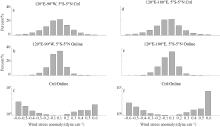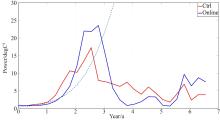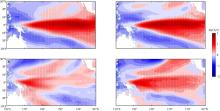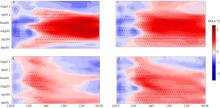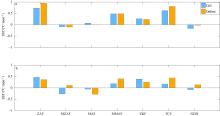Journal of Tropical Oceanography ›› 2023, Vol. 42 ›› Issue (1): 1-9.doi: 10.11978/2022038CSTR: 32234.14.2022038
Special Issue: 全球变化专题
Low-frequency wind stress forcing reduces El Niño diversity in numerical model
- 1. State Key Laboratory of Satellite Ocean Environment Dynamics, Second Institute of Oceanography, Ministry of Natural Resources, Hangzhou 310000, China
2. School of Oceanography, Shanghai Jiao Tong University, Shanghai 200000, China
3. Southern Marine Science and Engineering Guangdong Laboratory (Zhuhai), Zhuhai 519000, China
-
Received:2022-02-24Revised:2022-04-08Online:2023-01-10Published:2022-04-21 -
Contact:LIAN Tao. email:liantao@sio.org.cn -
About author:ZHANG Qi (1997—), male, master student. email: zghydxzq@163.com -
Supported by:National Natural Science Foundation of China(42022043); Zhejiang Provincial Natural Science Foundation of China(LR19D060001)
Cite this article
ZHANG Qi, LIAN Tao. Low-frequency wind stress forcing reduces El Niño diversity in numerical model[J].Journal of Tropical Oceanography, 2023, 42(1): 1-9.
share this article
Add to citation manager EndNote|Reference Manager|ProCite|BibTeX|RefWorks
| [1] |
doi: 10.1029/2006JC003798 |
| [2] |
doi: 10.1175/1520-0493(1969)097<0163:ATFTEP>2.3.CO;2 |
| [3] |
doi: 10.1029/1999GL900161 |
| [4] |
|
| [5] |
doi: 10.1038/ngeo2399 |
| [6] |
|
| [7] |
doi: 10.1175/JCLI-D-17-0526.1 |
| [8] |
doi: 10.1175/JCLI-D-18-0854.1 |
| [9] |
doi: 10.1175/1520-0469(2000)057<2936:ESPLTT>2.0.CO;2 |
| [10] |
doi: 10.1175/1520-0442(1997)010<3131:WWEITT>2.0.CO;2 |
| [11] |
doi: 10.1175/1520-0469(1997)054<0811:AEORPF>2.0.CO;2 |
| [12] |
doi: 10.1029/1999GL011023 |
| [13] |
doi: 10.1175/2008JCLI2309.1 |
| [14] |
doi: 10.1175/2008JCLI2624.1 |
| [15] |
|
| [16] |
doi: 10.1175/JCLI-D-18-0821.1 |
| [17] |
|
| [18] |
doi: 10.1029/JC093iC09p10589 |
| [19] |
doi: 10.1175/2008JCLI2334.1 |
| [20] |
doi: 10.1126/science.222.4629.1195 |
| [21] |
doi: 10.1175/JCLI-D-12-00601.1 |
| [22] |
doi: 10.1175/1520-0469(1988)045<0549:VIACOM>2.0.CO;2 |
| [23] |
doi: 10.1175/JAS3539.1 |
| [24] |
doi: 10.1007/PL00007920 |
| [25] |
|
| [26] |
doi: 10.1007/s00382-019-05034-2 |
| [27] |
|
| [28] |
doi: 10.1038/s41467-019-11720-w pmid: 31439837 |
| [29] |
doi: 10.1002/joc.2336 |
| [30] |
doi: 10.1175/2010JCLI3171.1 |
| [31] |
doi: 10.1029/2018GL077664 |
| [32] |
doi: 10.1029/2002JC001498 |
| [1] | YUAN Yu, XU Haiming, MA Jing, ZHANG Tong. Impact of Atlantic Multidecadal Oscillation on interannual relationship between ENSO and early summer marine heatwaves in the Western Pacific* [J]. Journal of Tropical Oceanography, 2024, 43(5): 1-16. |
| [2] | HAN Dingyan, LI Min, HU Rui, XIE Lingling. Variation and mechanisms of autumn tropical cyclones landed in Guangdong [J]. Journal of Tropical Oceanography, 2024, 43(1): 64-78. |
| [3] | QUAN Mengyuan, WANG Hui, LI Wenshan, WANG Aimei, LUO Jingxin. The interannual variation of summer upwelling in Zhoushan Islands and its relationship with ENSO [J]. Journal of Tropical Oceanography, 2024, 43(1): 48-55. |
| [4] | LI Chengyong, MENG Xiangfeng, XIE Ruihuang. Interdecadal modulation of ENSO asymmetry by the Pacific Decadal Oscillation and its mechanism [J]. Journal of Tropical Oceanography, 2023, 42(4): 36-46. |
| [5] | ZHANG Yuhong, ZHANG Lianyi, DU Yan. Tropical ocean-atmosphere coupling modes and their relationship with ENSO during spring* [J]. Journal of Tropical Oceanography, 2023, 42(2): 34-44. |
| [6] | YANG Shaoqiong, CHENG Dan, CHEN Guangyao, LUO Chenyi, NIU Wendong, MA Wei, FA Shuai. Review on the application of underwater gliders for observing typical ocean phenomena [J]. Journal of Tropical Oceanography, 2022, 41(3): 54-74. |
| [7] | Wenxi CAO, Zhaohua SUN, Cai LI, Guowang ZOU. Biofouling protection for water quality monitoring buoy and sensors [J]. Journal of Tropical Oceanography, 2018, 37(5): 7-12. |
| [8] | Huawei QIN, Zhuo TAO, Huaiming LI, Xihe YUE, Zhen CAI, Sheng CHEN, Hongwei ZHOU, Ying YE. Development and application of chemical sensor for hydrothermal vents detection [J]. Journal of Tropical Oceanography, 2018, 37(3): 86-92. |
| [9] | Jiguang LI, Dongkai WANG. Research on ghost suppression and notch compensation of dual-sensor ocean bottom cable data [J]. Journal of Tropical Oceanography, 2018, 37(2): 100-104. |
| [10] | Lianghong LÜ, Xiaotong ZHENG. The effect of Indian Ocean Basin mode on Indian Summer Monsoon Rainfall in decaying year of El Niño [J]. Journal of Tropical Oceanography, 2017, 36(2): 1-11. |
| [11] | YANG Yali, DU Yan. Decadal variability of oceanic advection in the South China Sea associated with ENSO and Indian-Ocean Basin and its impacts on SST [J]. Journal of Tropical Oceanography, 2016, 35(1): 72-81. |
| [12] | JIN Xiao-lin, LI Zhong-xian, ZHENG Zhi-hai, WANG Da-jun. Interannual variability of the TIWs and its relationship with the ENSO [J]. Journal of Tropical Oceanography, 2015, 34(3): 30-35. |
| [13] | DONG Xian-xin, JIANG Kai, CHEN Hang, YE Shu-ming. A design of deep-sea extreme environment simulator [J]. Journal of Tropical Oceanography, 2014, 33(2): 101-108. |
| [14] | HONG Mei, ZHANG Ren, YU Dan-dan, DONG Zhao-jun, LI Can. Diagnostic analysis of nonlinear correlation characters between the variables in the tropical Pacific Ocean and ENSO [J]. Journal of Tropical Oceanography, 2014, 33(2): 28-36. |
| [15] | SONG Shao-hua, ZHOU Wei-jian, XIONG Xiao-hu, PENG Zi-cheng, LIU Wei-guo, CHEN Te-gu. Variability of winter monsoon in the South China Sea during 1818-2000: Evidence from stable oxygen isotope records in coral [J]. Journal of Tropical Oceanography, 2013, 32(1): 18-25. |
|
||





